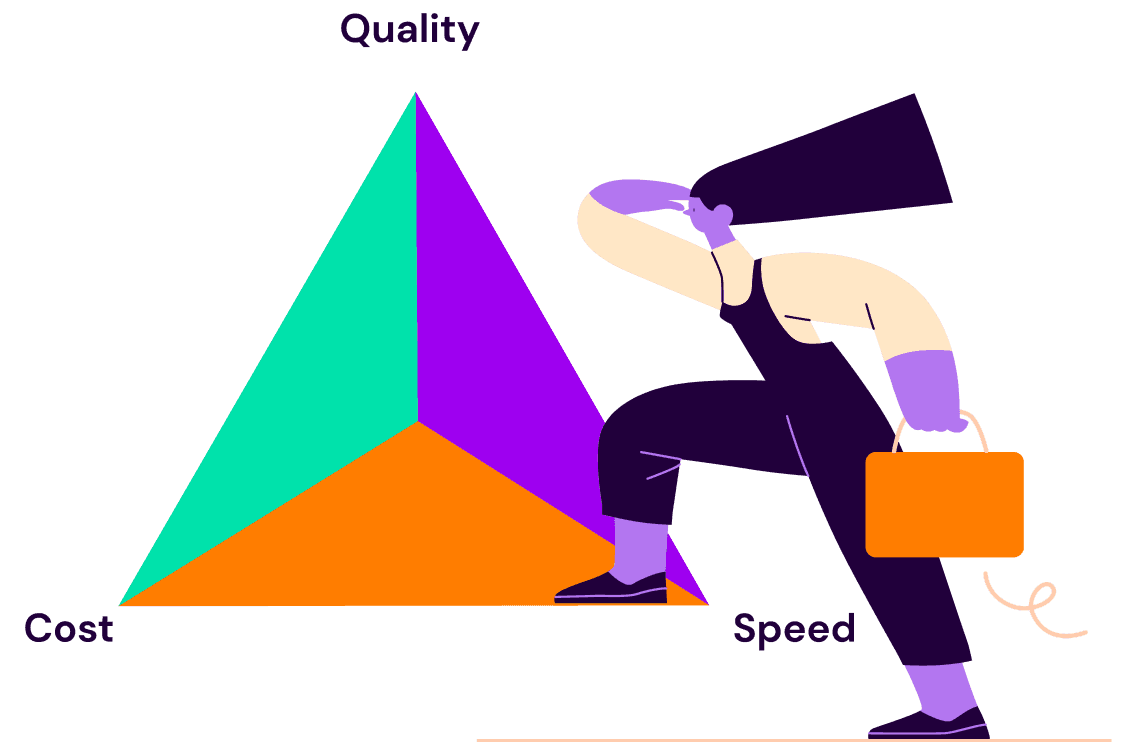
Back to blogs
This is the first post in a blog series where we’ll explore how healthcare recruiters can implement a sourcing strategy to build talent pipelines. In this series, you’ll learn why sourcing is important, where to find and connect with qualified, passive candidates, how to communicate the differentiated value of your organization, and tips to improve your recruiting efficiency.
I) Why healthcare recruiters need a sourcing strategy
1. Healthcare roles are in high demand, with no sign of slowing
According to the US Bureau of Labor Statistics, employment in healthcare will grow by 13% between 2021 and 2031. Four of the top 20 roles with the highest projected percent change of employment are in healthcare—with nurse practitioners in the number one spot.
Driven by high turnover from pandemic burnout and a large number of nurses reaching retirement age, the nationwide shortage of nursing talent is further complicated by an aging population demanding care. Some healthcare systems have turned to hiring traveling nurses as a temporary solution, but this is incredibly expensive and unsustainable. On top of the talent shortage, recruiting teams face stiff competition from other hospitals or health systems.

Related content: Get the ebook Healthcare Staffing Trends to Watch in 2023.
2. It’s time to ditch the ineffective “post and pray” method of hiring
A sole reliance on job boards is limiting for the quality and diversity of your candidate pipeline, while extremely slow and costly to actually fill critically needed roles. Alternatives like recruitment process outsourcing and executive search firms may shorten your time-to-fill, but often at a steep price—typically between 20%-30% of a role’s first-year salary!
It may sound grim, but there’s good news, too. Advancements in technology are making specialized healthcare talent easier to find—but it’s up to you to engage them and bring them into your organization.
Since many healthcare recruiters get into recruiting from healthcare backgrounds, rather than HR backgrounds, you’ve likely already got a leg up with your real-world experience. You can bring even more value to your organization by building your recruiting skills and evolving your talent acquisition program. The key is to develop a sourcing strategy to find potential candidates who may not be actively seeking employment but could be open to new opportunities.

“Gone are the days where you ‘post and pray’ and you get this whole onslaught of individuals interested in joining the team. Sourcing now has to be part of the bread and butter of what you’re doing every single day.”
—Lindsey Breiner, System Director of Talent Acquisition, Main Line Health
3. What exactly is sourcing?
Sourcing is actively searching for potential candidates who meet your job qualifications using methods such as social media, networking, and direct outreach, often with the help of recruiting technology. In contrast, “post and pray” relies on inbound applicants who apply for a job on their own, typically in response to a job posting or advertisement. While sourcing candidates requires more proactive effort and creativity, it can reduce your time-to-hire, reactive management and screening, and expenses associated with processing inbound applicants.
“Post and pray” | Sourcing |
Reactive and limiting: First, active job seekers must discover your opportunity; then you have to screen for qualified applicants. | Proactive and targeted: You can locate and engage a wider pool of passive candidates that already meet your requirements. |
Shortsighted: You’re focused only on the positions that are open right now. | Long-term: You’ll build relationships and create a pipeline of qualified talent that you can re-engage at the right time. |
Expensive and time-consuming: Spending on job boards (sunk costs!) adds up over time if roles aren’t filled quickly. | Cost-effective in the long run: An initial investment can bring fast ROI with powerful, reusable tools and processes. |
II) Understanding roles and your employer value proposition
Recruiting is a lot like sales in that it requires effective communication, negotiation skills, and a deep understanding of the needs and motivations of the people you are working with. In addition to familiarity with each job and its functions, “selling” the roles you’re hiring for requires a fundamental knowledge of what your organization uniquely offers its employees. As you engage with candidates and learn about their needs, you’ll be better poised to make meaningful connections and find the talent that best fits at your company.

“We are the brand ambassadors of our organization, and so many people think that just putting a posting out there is going to attract people. The human element is what is really going to draw people to want to come work for your organization.”
—Matt Craven, Manager of Talent Acquisition and Workforce Planning, PeaceHealth
1. Hone your employer value proposition
Your employer value proposition (EVP) is your unique set of offerings, benefits, and rewards that your organization provides to its employees in exchange for their skills, experience, and performance.
Your EVP communicates the unique aspects of your organization's employment experience, and what sets it apart from other employers. This typically includes a combination of tangible and intangible elements, such as salary and benefits, career development opportunities, work-life balance, company culture, mission, and values.
Having a strong EVP will help your organization attract and retain top talent, as it demonstrates to prospective and current employees that your organization values their contributions and cares about their overall well-being.
If your organization hasn’t formulated an EVP, the best place to start—and to find what really differentiates you from others in your space—is to center your purpose. Think of the effects of your work all the way downstream. For example, in healthcare, your impact goes all the way to patient outcomes. Centering your purpose will help you attract folks who are mission-driven and share your values.
2. Know the ins and outs of the position
It’s important as a healthcare recruiter that you deeply understand the needs and desired outcomes for each position you’re filling. This helps you hone your search for more effective sourcing and screening, lends to more meaningful conversations and connections with prospects, and saves everyone time by minimizing the chances of advancing candidates that aren’t a good fit.
The most effective way to understand the roles you’re looking to fill is by meeting with hiring managers. After all, you’ll be working together to identify and evaluate candidates. This also helps you strengthen relationships and build trust with your hiring managers, ultimately leading to a more efficient and effective hiring process.
Here are some questions to guide the discussion.
Getting a solid sense of the position
Why does the role exist, and why are we hiring for it?
What are the skills and qualifications needed for this role? Which are the hard requirements that you absolutely need versus those that are nice to have? Are there any constraints, like licensing requirements?
How much experience should each candidate have? Are there particular projects, systems or tools, or expertise that an ideal candidate would have?
What will they do day to day? Why does it matter? What does success look like? What kind of impact can they have?
Learning about the working environment
What’s the culture or “vibe” of the team? Which other teams will this role work closely with?
What’s the leadership like on the immediate team and its larger branch within the organization?
What are the unique values and goals of this team? How does it support the organization’s overall mission?
What kind of diversity exists on the team, and within the larger organization?
Is the location of the role important? Can it be remote, or hybrid? Will the position require travel?
Establishing clear expectations
What’s the expected timeline to fill this position?
What will the interview process look like, and who needs to be involved?
How will a hiring decision be made?
Identifying potential challenges
Is this a role that’s historically challenging to fill? Why?
Is there a shortage of qualified candidates for this position?
What tradeoffs can be made to broaden or improve the talent pool?
III) Planning your search
Now that you’ve gleaned a deep understanding of each role from your hiring managers, it’s time to prepare for your search. With more sourcing experience, this part of the process becomes easier and faster—especially if you hire for multiple positions with similar functions.
1. Define your talent pool and gather your search terms
What will your ideal candidate look like? Consider the following:
Skills and experience—including what’s required vs. nice to have
Licensure, specialization
Job title(s)
Importance of diversity
Location(s)
Competitors
Now, think of all the different ways people may represent the experiences or accomplishments you’re looking for on their resumes. Building an expanded keyword list will help you cover more ground in your search. For example, some candidates may list “Electronic Medical Record” while others abbreviate and just use “EMR.” At the same time, if you’re looking for a radiologist but not a radiographer, you’ll need to get more specific than a general search term like "X-ray."
What other connections might help you locate candidates with the qualifications you’re after? Think about other organizations a candidate may be (or has been) a part of—like specific schools, groups, affiliations, and even other past or current employers.
2. Where to source healthcare talent
Free tools and public databases
Using free tools to source hard-to-find healthcare talent is possible, but it’s often cumbersome, and requires a lot of time, effort, and technical know-how. Many databases are also specialized, so the information you can find is likely inconsistent as you look across different states, industries, or professions. Keep in mind that many also contain people who have retained licenses but no longer practice.
US state license registries are state-specific, often industry-specific, and the quality and depth of information can greatly vary depending on which professions you search.
Certification sites may offer national databases, but are siloed by specific certifications with varying levels of access available.
NPI (National Provider Identifier) database includes any licensed provider that bills Medicare or Medicaid. This includes most doctors and some nurses that bill patients.
Doximity, Healthgrades, and similar databases contain physicians and some nurses.
Insurance sites, large hospital sites, or other online directories may offer some licensed candidates, but information is limited and inconsistent.
Additionally, healthcare professionals don’t always use the same social networking sites as many other professionals do. For example, while some nurses are on LinkedIn, many are not—which means this already limited talent pool is likely being contacted by your competitors, too.
Not only is there not an efficient way for companies to search stage registries to get a comprehensive view of nursing talent, but getting accurate contact information for these candidates is challenging, too.

Related content: Watch the on-demand webinar Advanced Sourcing for Healthcare Professionals.
Recruiting technologies
Your applicant tracking system (ATS) may be a great place to start while looking for talent. An ATS is a goldmine of data, containing a database of candidates who have previously expressed interest in your company, including “silver medalists” who have already been through your interview process. However, this limits you to the candidates you’ve engaged with before.
Some sourcing technology solutions, including SeekOut, offer specialized healthcare talent pools. It’s recommended that you look carefully into what each provider offers, doing a comparison of the top vendors on your shortlist. Important aspects to evaluate include:
Sizes of the talent pools and relevancy of candidates
Features and functionality of each platform, including integrations
How each vendor supports its customers (i.e. support resources, training, and people like account managers and customer success teams)
Each providers’ expertise and commitment to continued investments that support your industry-specific needs
Expected deployment and onboarding timelines
Pricing and licensing
Networking and recruiting events
Networking and recruiting events, including job fairs, present an opportunity to meet potential candidates and introduce your employer brand to folks interested in your industry. It’s wise to select events that are relevant to your target audiences, and to be prepared with an engagement plan for following up with promising candidates.
Referral programs
Employee referral programs are often a valuable source of qualified candidates who may not have been reached through other recruitment efforts. Additionally, referrals tend to have higher retention rates and better cultural fit, as they come from a trusted source who knows the organization well.
Creative partnerships
Some health systems are implementing innovative public-private partnerships with educational institutions. For example, the University of South Carolina’s College of Nursing entered a partnership with the Lexington Medical Center to build a new facility on the hospital’s campus for nursing simulation and clinical training. This promises an 80% annual increase of nursing graduates to help address the talent shortage in the area.
Talent acquisition professionals in healthcare are also reaching out to high schools and colleges to educate students on the vast opportunities in healthcare that extend beyond nursing and provider roles, like IT, marketing, administration, and more.
Healthcare-specific job boards
Although one of the great promises of a sourcing strategy is less reliance on job boards, they may still be an important source of talent for your organization. There are plenty of articles and review sites that aggregate various healthcare-specific job boards—here are some that we noticed were featured across a variety of sites, including a handful with special focus areas:
Popular healthcare job boards | Specialized healthcare job boards |
CareerVitals.com | Nurse.com (nurses) |
HealtheCareers.com | MDJobSite.com (physicians) |
HealthJobsNationwide.com | BioSpace.com (life sciences) |
Careers.JAMANework.com | MomMD.com (women in medicine) |
Want more?
Read the next installment of our "beyond post and pray" series for an introduction to Boolean search and candidate engagement best practices.
Learn more about SeekOut for Healthcare, which provides the most robust database of more than 31 million doctors, nurses, and other healthcare professionals. See it in action—request a demo today.
See us in action
Learn how SeekOut unifies people data to help organizations reach their talent goals
Request a demo




